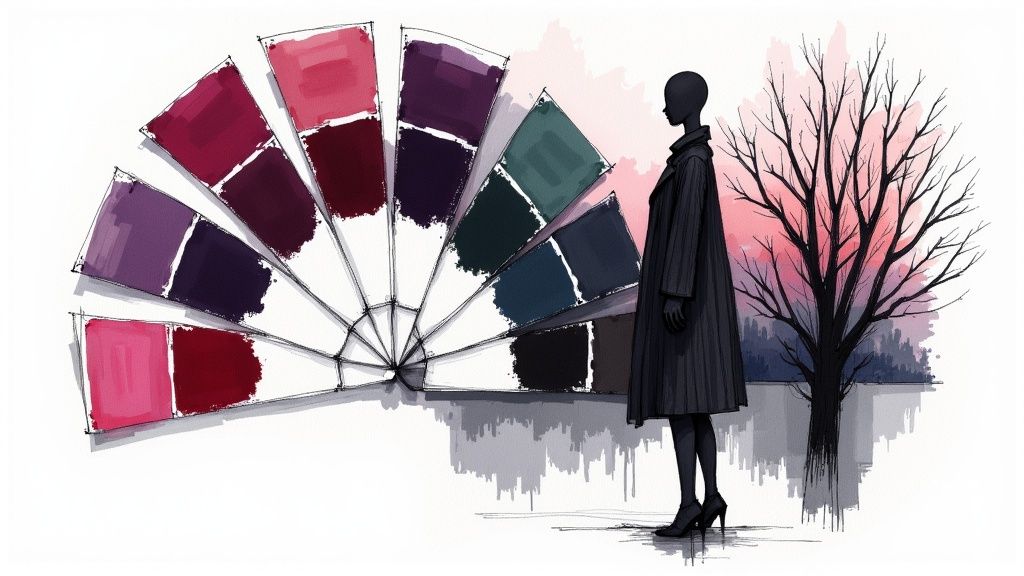
Your Guide to the Deep Winter Color Palette
By Emma Johnson - 10/2/2025
So, what exactly is the Deep Winter color palette? Think of a collection of intensely saturated, cool, and dark colors that perfectly complement someone with high contrast between their hair, skin, and eyes. It's all about rich jewel tones like emerald green and sapphire blue paired with bold, crisp neutrals like true black and charcoal gray.
This palette beautifully marries the icy coolness of Winter with the signature depth of Autumn.
Decoding the Deep Winter Palette
Picture a forest at twilight. The colors aren't muted or dusty; instead, they're deepened and intensified by the dimming light. That powerful, dramatic feeling is the very essence of the Deep Winter palette.
It’s a sophisticated and striking range of shades defined by three main traits: cool undertones, deep value, and high contrast. These colors are a world away from the soft pastels of a Light Summer or the earthy tones of a Warm Autumn. Deep Winter is all about clarity and drama.
This palette sits at a fascinating intersection of two seasons. In color analysis, Deep Winter borrows its crisp, blue-based undertones from the Winter family but gets its rich, profound depth from the neighboring Autumn season. At its core, having a solid understanding cool tones is the key to mastering this look. Your best colors will always feel grounded and substantial, never muted, dusty, or overly warm.
Let's quickly recap the key characteristics that define the Deep Winter palette. This table provides a snapshot of what makes this season so unique.
Deep Winter Palette At a Glance
| Characteristic | Description |
|---|---|
| Primary Aspect | Deep. The colors are profoundly saturated and dark. |
| Secondary Aspect | Cool. Hues have a distinct blue-based, icy undertone. |
| Tertiary Aspect | Clear. Colors are pure and crisp, not muted or dusty. |
| Contrast | High. This palette thrives on bold pairings of light and dark. |
| Sister Season | Borrows its depth from Deep Autumn. |
Ultimately, a Deep Winter's natural coloring is their greatest asset, and this palette is designed to enhance it, not overpower it.
The Core Characteristics
So, what really makes someone a Deep Winter? It all comes down to a few key elements that create a powerful harmony.
Primary Aspect - Deep: The most important trait here is depth. All the colors in this palette are rich and saturated, steering clear of anything that feels light, pale, or pastel.
Secondary Aspect - Cool: These colors have a noticeable blue or cool base. You won’t find any warm, golden, or earthy tones here. Instead, imagine colors that have been chilled by a winter frost.
Contrast Level - High: Deep Winters look their best when they embrace high contrast. Pairing a very dark color with a very light or bright accent—like pure white or an icy lemon yellow—creates a visually stunning effect that mirrors their natural coloring.
This unique combination of traits sets Deep Winter apart. While it's part of the Winter family, its defining feature is that profound saturation. The colors are darkened, sometimes with a subtle hint of brown that adds richness and distinguishes them from the brighter, icier hues of a True Winter.
Key Takeaway: Being a Deep Winter isn't just about wearing dark colors; it's about wearing deep, cool, and clear colors that match your own natural intensity. Embracing this palette means choosing shades that mirror the powerful contrast already present in your features.
If you're starting to wonder if this sounds like you, the next step is to explore your own seasonal color type. Our guide on finding out what is my color season is the perfect place to begin your journey.
How to Know If You Are a Deep Winter
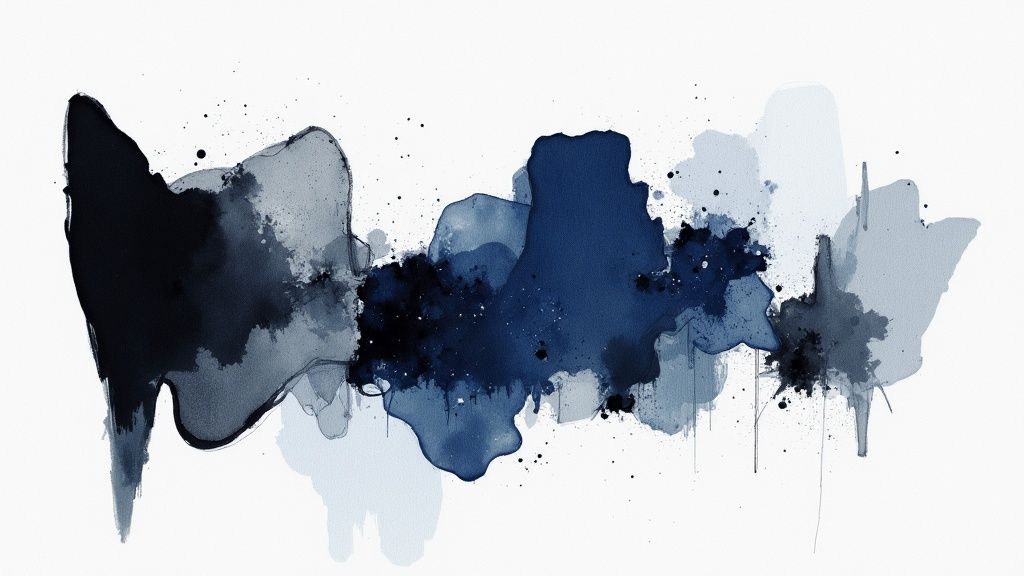
Figuring out your color season isn't about ticking off boxes on a rigid checklist. It’s much more about the overall vibe your features create together. For Deep Winters, that vibe is all about a powerful, high-contrast look that comes from deep, cool coloring. It's a striking combination of intensity and coolness that really makes you stand out.
The most common thread you'll find among Deep Winters is dark hair—we're talking everything from a deep, rich brown to jet black. This dark hair acts as a dramatic frame for your face. When you pair that with skin that has cool or neutral-cool undertones, you get that signature contrast that lets the Deep Winter palette shine.
Not quite sure where your skin's undertone lands? That's probably the most important piece of the puzzle. You can get a much clearer picture with our detailed warm vs. cool undertone test.
Analyzing Your Key Features
Let's dig into the specific features we usually see. Of course, there are always exceptions to the rule, but if you find yourself nodding along to these descriptions, it’s a very strong sign you’re in the Deep Winter club.
Your Hair Color: Your natural hair color is almost always dark. Think along the lines of rich chocolate brown, dark espresso, or a true, pure black. If you have any natural highlights, they'll lean cool and ashy, never warm and golden.
Your Eye Color: Deep Winter eyes are typically dark and piercing. They can be a deep brown, black-brown, a cool-toned hazel, or even a very deep, icy shade of green or blue that looks dark from a distance. The main thing is that feeling of depth.
Your Skin Tone: Your skin has a cool or neutral-cool undertone. This means you might see subtle pink, bluish, or even olive hints, but you won't see the golden or peachy warmth found in other seasons. This cool canvas is what makes the bold colors in your palette look so incredible.
Deep Winter Litmus Test: How do you feel when you wear pure black or pure white? Do these stark colors make you feel sharp and energized, or do they completely wash you out? For a true Deep Winter, high-contrast neutrals like these are your superpower—they make your features pop with stunning clarity.
The Overall Impression Matters Most
Ultimately, try not to get too hung up on a single feature. What truly defines a Deep Winter is the combined effect of everything working together. The overarching theme is contrast and richness. There’s a dramatic, noticeable difference between the color of your hair, your skin, and your eyes.
Think of celebrities like Anne Hathaway, Lucy Liu, or Penélope Cruz. They all look different, yet they share that signature high contrast and deep, cool coloring. If your natural features create a similar sense of drama and intensity, chances are very high that you're a Deep Winter.
Getting to Know the Deep Winter Color Spectrum
Alright, let's get into the fun part—the colors themselves. The Deep Winter color spectrum is a curated collection of shades that are practically guaranteed to make your natural features pop. Think of a jeweler's box brimming with the most vivid, precious gems. Those are your colors.
These hues aren't just a random assortment of dark shades. Each one is specifically selected for its incredible depth and cool, blue-based undertones. To really get a handle on why these specific colors work so well together, it helps to understand the foundational principles of color theory. A little background knowledge can make all the difference in seeing how these shades create such a striking harmony with your natural coloring.
The Essential Neutrals
Every amazing wardrobe is built on a solid foundation of neutrals. For Deep Winters, this means leaning into powerful, crisp shades that create a stunning canvas for your more vibrant colors. Forget the soft, muted tones you might see in other seasonal palettes; your neutrals are bold and defined.
- Pure Black: This is your power neutral. While it can easily overwhelm other seasons, on you, it looks sharp, sophisticated, and effortlessly chic.
- Charcoal Gray: A slightly softer, yet still impactful, alternative to black. It adds a wonderful sense of dimension and class to any outfit.
- Pure White: The stark contrast of a crisp, optic white is what high-impact looks are made of. Paired with your darker colors, it’s pure magic.
- Navy Blue: A deep, inky navy works beautifully as an alternative to black, offering a similar depth with a touch more richness.
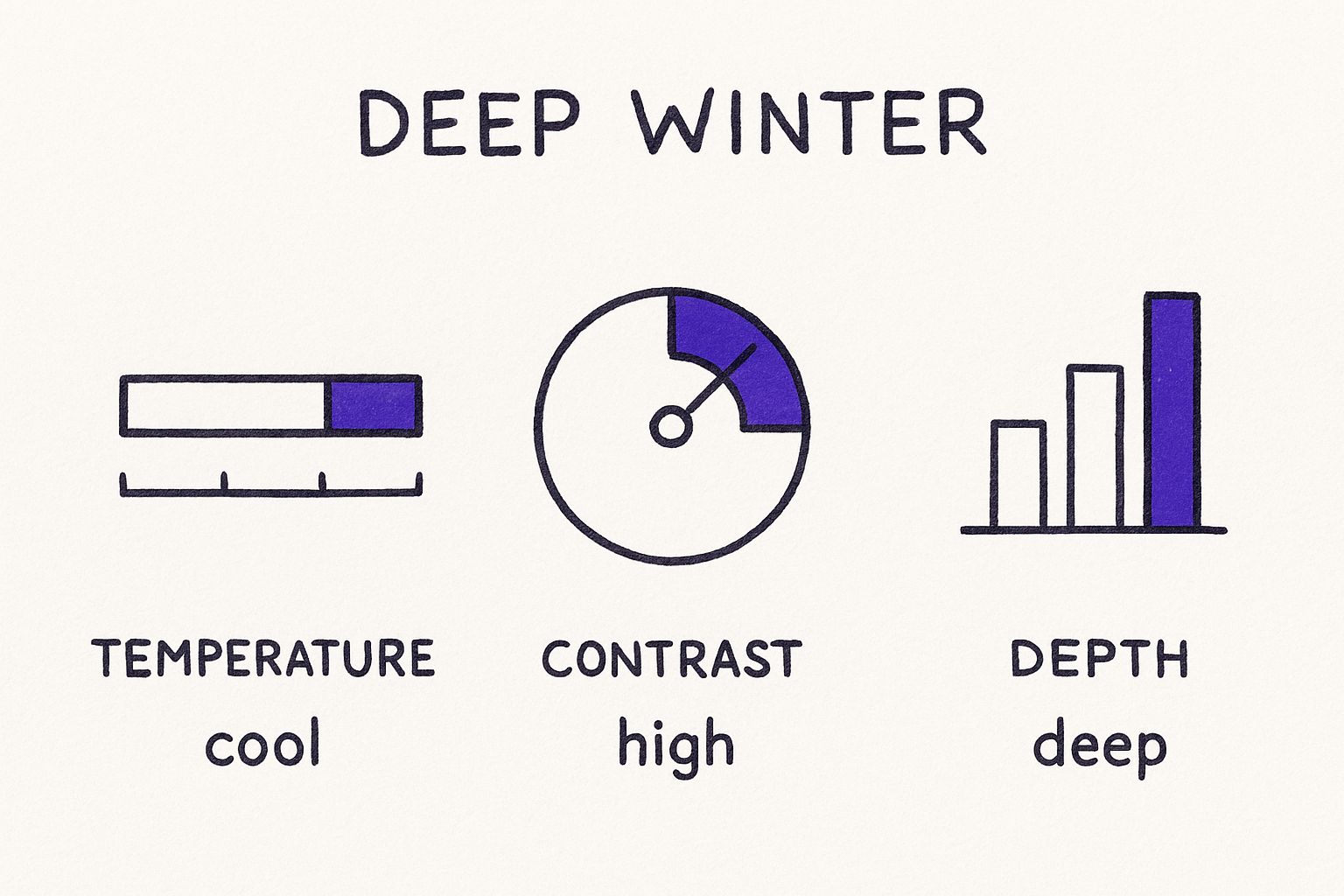
As this breakdown shows, the entire palette is defined by its deep value, cool temperature, and high contrast. That's precisely why these bold neutrals provide the perfect starting point.
Your Statement-Making Power Colors
With your core neutrals sorted, it's time to bring in the heart of the Deep Winter palette: the vibrant, saturated jewel tones. These are the colors that will truly bring a glow to your skin and command attention wherever you go. Think bold, clear, and unapologetically rich.
These hues are your secret weapon for making an unforgettable impression. Don't be afraid to embrace them!
Punchy Accent Colors
Last but certainly not least, let's talk about the bright, zesty accents that add a final pop of energy. These colors are often best used in smaller doses to create a focal point—a scarf, a handbag, or even a bold lipstick. They provide that exciting, finishing touch that pulls your whole look together.
- Hot Pink & Fuchsia: These electrifying pinks give you a stunning, cool-toned burst of vibrant color.
- Lemon Yellow: Not just any yellow, but a sharp, icy version that cuts through the darkness of your other colors beautifully.
- Emerald Green: This is the ultimate jewel tone. It looks incredibly luxurious and regal on Deep Winters.
- True Red: A classic, blue-based red that is both timeless and incredibly powerful. A must-have in any Deep Winter's closet.
Deep Winter vs Bright Winter Key Differences
It's really common for people to get confused between Deep Winter and its sister season, Bright Winter. Both are cool and high-contrast, but the primary characteristic that defines them is different. Here’s a quick table to help you spot the key distinctions.
| Attribute | Deep Winter | Bright Winter |
|---|---|---|
| Primary Trait | Deep / Dark | Bright / Clear |
| Secondary Trait | Cool | Cool |
| Dominant Undertone | Cool with a neutral influence | Purely Cool |
| Best Colors | Rich jewel tones, deep berries | Electric, neon-like hues |
| Best Neutrals | Black, charcoal, deep navy | Black, pure white, cool grays |
| Worst Colors | Muted, earthy, warm tones | Dusty, muted, warm pastels |
| Celebrity Example | Anne Hathaway, Penelope Cruz | Courteney Cox, Megan Fox |
Understanding this difference is crucial. While both seasons are part of the Winter family, wearing Bright Winter's electric shades can sometimes feel a bit "off" if your dominant trait is depth, and vice versa. Knowing your primary characteristic helps you fine-tune your palette perfectly.
Building Your Ultimate Deep Winter Wardrobe
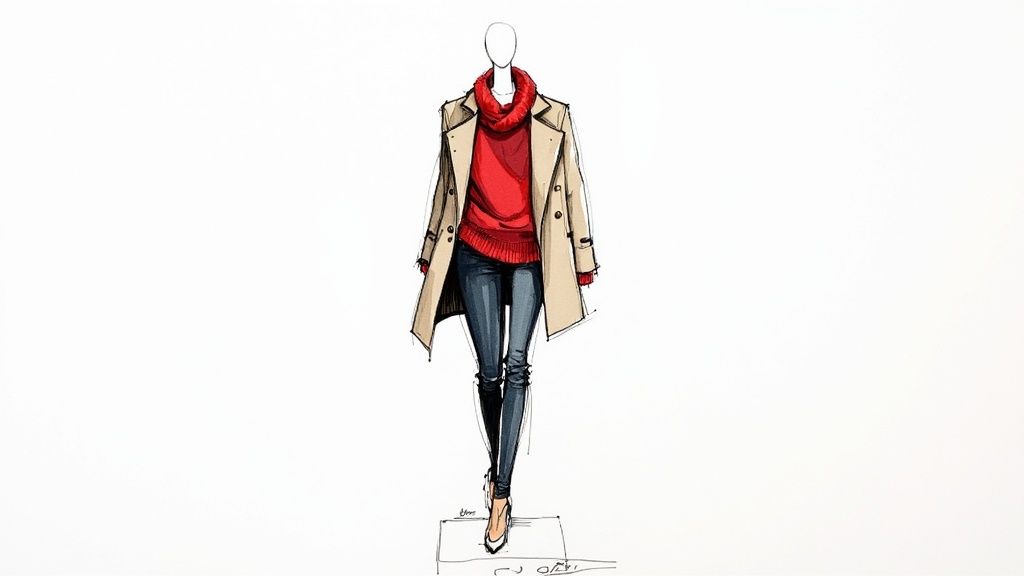
So, you've discovered you're a Deep Winter. That's the fun part. But figuring out how to translate that knowledge into a closet full of clothes you actually love to wear? That can feel like a totally different challenge.
The goal isn't to purge everything you own overnight. It’s about being intentional. Think of this as your roadmap for slowly and strategically building a wardrobe where everything works together, making you look and feel incredible.
The secret to a truly functional closet is starting with a solid foundation. You wouldn't paint the walls of a house before they're built, right? It’s the same with your wardrobe. For a Deep Winter, that foundation is built on powerful, crisp neutrals.
These are the workhorse pieces that will form the backbone of your style. They create the perfect canvas, allowing your most stunning, vibrant colors to really sing.
Start with Foundational Neutrals
First things first, let's lock down your core neutrals. These are the colors you'll turn to for coats, blazers, trousers, and those essential everyday tops—the pieces that ground your look and give you endless mixing-and-matching potential.
Deep Winter neutrals are anything but dull. They are deep, defined, and inherently chic.
Here are the non-negotiables for your closet:
- True Black: This is your ultimate power neutral. Don't be afraid to invest in it for classic pieces like a sharp wool coat, perfectly tailored trousers, or a killer leather jacket.
- Charcoal Gray: A slightly softer, but no less sophisticated, alternative to black. It’s fantastic for suiting, cozy knitwear, and simple basics.
- Pure White: Nothing creates that signature Deep Winter pop quite like pure, optic white. A crisp white shirt or a simple tee is an absolute must-have for creating that striking contrast you wear so well.
- Deep Navy: An elegant and rich substitute for black. It’s perfect for blazers, dark-wash jeans, and anything requiring a touch of professional polish.
Once you have a solid base of these neutrals, putting outfits together becomes almost effortless. If you want to dive deeper into finding the right base shades, our guide on the best neutral colors for my skin tone is a great next stop.
Introduce Your Power Colors
With your neutral foundation firmly in place, it’s time for the main event. This is where you bring in the soul of your palette: those stunning, statement-making jewel tones that make your features come alive.
Think of these colors as the stars of the show. A great way to start is by adding pieces that sit close to your face, where they’ll have the biggest and most flattering impact.
- Tops and Blouses: An emerald green silk blouse or a rich ruby red sweater isn't just a piece of clothing; it’s an instant statement.
- Dresses: A dress in sapphire blue or deep fuchsia is a complete showstopper, ready for any occasion where you want to turn heads.
- Statement Coats: Imagine a classic trench in a deep burgundy or a cozy wool coat in forest green. It can completely elevate your entire winter look.
It’s not just in person that these colors command attention. The visual punch of these shades is so powerful that Deep Winter color palettes achieve 30% higher interaction rates in online settings. Viral trends featuring these hues can impact retail inventory in as little as 48 hours.
Finish with Bold Accent Colors
Finally, let’s talk accents. These are the bright, energetic colors you can sprinkle in to add personality and a final touch of flair. They're perfect for accessories, giving you a way to play with a bold pop of color without having to commit to a full garment.
Think about using your accent colors for:
- Scarves and Handbags: A flash of hot pink from a scarf or a lemon-yellow clutch can instantly energize an all-neutral outfit.
- Shoes: A pair of true red heels or cobalt blue flats can become a surprising and incredibly stylish focal point.
- Jewelry: Bold earrings or a statement necklace in emerald or fuchsia is the perfect finishing touch to complete your look with confidence.
Building your wardrobe this way—neutrals first, then power colors, and finally accents—is the key. It ensures every piece you bring into your closet works together to create a cohesive, harmonious, and uniquely you style.
Perfecting Your Deep Winter Makeup Look
Think of your Deep Winter palette as more than just a wardrobe guide—it’s the key to your entire look, right down to your makeup and even your hair color. The same rules apply here: high contrast, cool tones, and rich depth are your secret weapons for creating a look that feels completely cohesive. When you get this right, your whole beauty routine simplifies. You’ll just know which shades make your features sing.
When your makeup is in sync with your natural coloring, the effect is truly magnetic. Colors that might seem way too bold or intense on other people will look effortlessly chic and perfectly balanced on you. It’s all about working with the incredible clarity and richness you were born with.
Creating a Flawless Foundation
For a Deep Winter, your foundation should create a clean, crisp canvas that honors your cool or neutral-cool undertones. The biggest mistake you can make is choosing a base with strong yellow or peachy tones, which can instantly make your skin look dull or sallow. Instead, seek out shades described as porcelain, rose, sand, or cool beige.
When it comes to blush, you want to mimic a natural, brisk flush on a cold day.
- Berry and Plum: Deep, cool berry tones and rich plums look stunningly natural, adding a touch of sophisticated definition to your cheekbones.
- Cool Pinks: Don't be afraid of a brighter, blue-based pink. It can provide a beautiful pop of healthy color without ever looking orangey.
- Avoid: Make a point to steer clear of peach, coral, and warm terracotta blushes. These will clash with your cool coloring every time.
This approach ensures your cheek color blends seamlessly with your complexion instead of fighting against it, giving you a radiant, authentic glow.
"For a Deep Winter, makeup isn't about hiding or changing; it's about amplifying the natural drama and contrast you already possess. A bold, cool red lipstick doesn't just look good—it looks like it belongs."
Eyes and Lips That Pop
This is where you can really have fun and lean into the inherent drama of the Deep Winter palette. For eyeshadows, stick to cool, crisp shades that define your eyes without ever looking muddy. Think charcoal, deep navy, cool-toned taupes, and shimmering silver for a stunning effect. If you're craving a bit of color, a swipe of deep plum or forest green can look absolutely magnificent.
But let's be honest: lipstick is a Deep Winter's best friend. You can carry a bold, statement lip with an ease that other seasons can only dream of.
- Classic Reds: Your perfect red is a true, blue-based red—think deep, vibrant, and unapologetic.
- Rich Berries: Shades like raspberry, blackberry, and deep burgundy were practically made for you.
- Bold Fuchsias: A bright, cool fuchsia or a shocking hot pink creates an incredible high-contrast look that lights up your whole face.
The Best Hair Colors for Deep Winters
When it comes to hair, the most striking look almost always involves staying true to your natural depth and coolness. Often, simply enhancing your existing dark hair is the best path forward. Think cool-toned dark browns, rich espressos, or a soft, natural black that gleams.
Try to avoid warm, reddish highlights like caramel or auburn, as they can create a jarring disconnect with your cool skin tone. If you're truly itching for a change, consider a deep violet or a blue-black for a dramatic yet harmonious look that perfectly complements your palette.
Colors to Avoid as a a Deep Winter
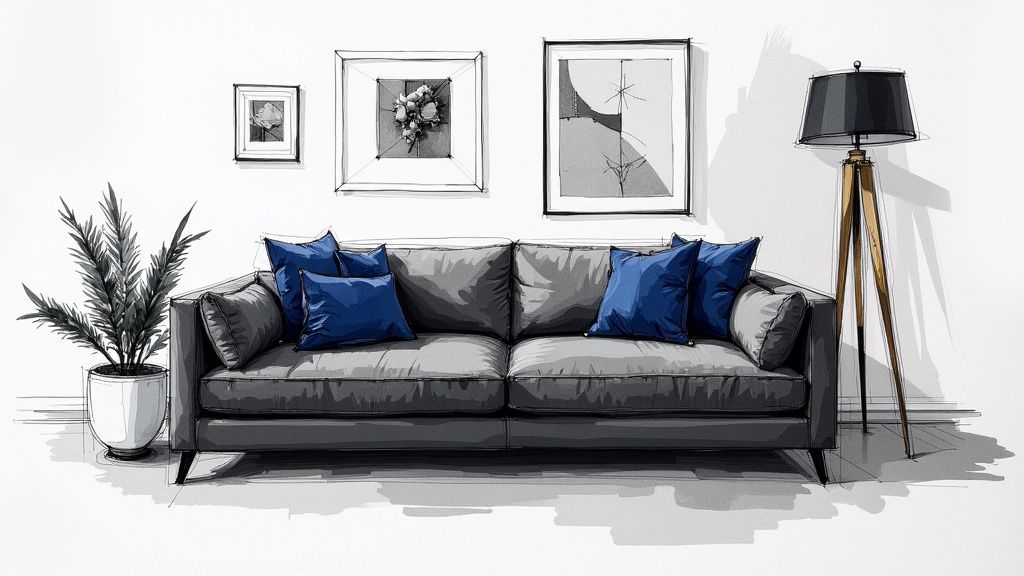
Knowing your best colors is only half the battle. Just as important is knowing which colors to leave on the rack, because the wrong ones can instantly drain your natural vibrancy and make you look tired.
For Deep Winters, the shades to watch out for are anything that feels warm, muted, or dusty. Your coloring is defined by its coolness and clarity, so introducing colors that lack those qualities creates a jarring effect. Think of it like a beautiful, crisp photograph losing its focus—the wrong colors can have that exact same blurring impact on your features.
The Main Colors to Sidestep
To stay looking sharp and radiant, you'll want to avoid a few specific color families. These shades simply don't have the cool depth your high-contrast coloring needs to pop.
Warm, Earthy Tones: This is the big one. Colors like mustard yellow, terracotta, olive green, and rusty oranges are your palette's opposite. Their inherent warmth clashes with your cool undertones, which can make your skin appear sallow.
Muted and Dusty Shades: Soft, hazy colors like dusty rose, sage green, and muted blues are problematic for a different reason. They lack the saturation and clarity you need. Against your bold features, they look faded and can make you look faded, too.
Light, Milky Pastels: While you can handle icy pastels from your own Winter palette, the softer, warmer pastels are a no-go. Think peach, light mint green, or a warm baby blue. They don't have enough depth or intensity and will look weak next to your strong coloring.
A Quick Tip: What if you absolutely love a color that isn't on your list? Don't worry, you can still wear it! The trick is to keep it as far away from your face as possible. A mustard-colored bag or a pair of terracotta shoes won't have the same draining effect as a scarf or blouse in that same shade. It’s a great way to indulge in a color you love without it washing you out.
Got Questions About Deep Winter? Let's Clear Things Up
Diving into any color season can bring up a few questions. This little Q&A is designed to tackle the most common head-scratchers about the Deep Winter palette so you can feel 100% confident as you start building your wardrobe.
One of the first things people ask is about hair and eye color. "Can I be a Deep Winter if I don't have dark hair and dark eyes?" Absolutely. While dark features are common, the real defining traits are your high contrast and cool undertones. Someone with piercing, icy blue eyes and almost-black hair is a perfect example of a Deep Winter. It’s all about that cool, dramatic contrast.
Deep Winter vs Deep Autumn
This is a big one. What’s the real difference between Deep Winter and its neighbor, Deep Autumn? In a word: undertone.
Both seasons are deep and rich, but Deep Winter is fundamentally cool (blue-based) and Deep Autumn is fundamentally warm (golden-based). Think of it like this: Deep Winter is a glass of chilled blackberry wine, while Deep Autumn is a mug of warm spiced cider. Both are dark and saturated, but one is crisp and cool, the other is earthy and warm.
Final Verdict on Jewelry: For a Deep Winter, cool-toned metals are your best friend. Stick with silver, platinum, and white gold. These metals will make your skin look bright and clear.
Yellow gold, on the other hand, often looks a bit "off" and can cast an unflattering yellow glow against your cool complexion. Choosing the right metals really is that final touch that pulls your whole look together beautifully.
Take your style to the next level with a professional analysis
You already know the theory. Now discover exactly which colors and styles enhance your personal image.
Loading...
Complete PDF report in less than 5 minutes
Your color season and personalized palette
Specific makeup and clothing recommendations
Based on professional color analysis
One-time investment:
One-time payment, no subscriptions. Instant access.